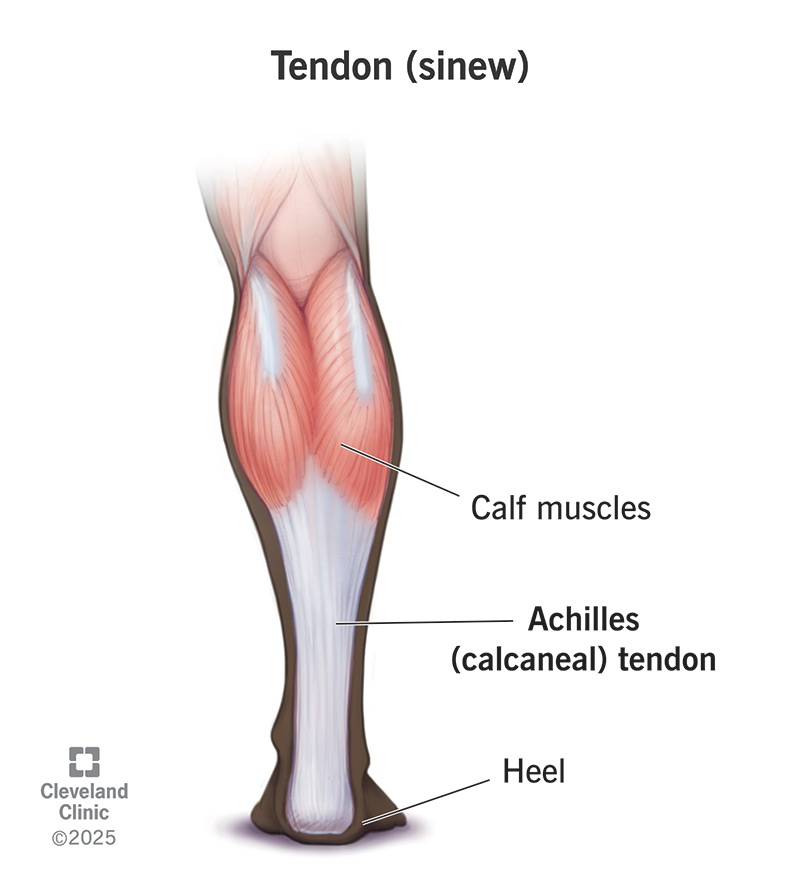Tendons (sinews) link your muscles to your bones. They let your bones move as your muscles tighten and relax. Overuse, injury, aging and health conditions, like arthritis, can damage your tendons. You can lessen the chances of sinew problems with a balanced exercise routine.
Advertisement
Cleveland Clinic is a non-profit academic medical center. Advertising on our site helps support our mission. We do not endorse non-Cleveland Clinic products or services. Policy

A tendon, or sinew, is a cord of strong, flexible tissue, similar to a rope. Tendons connect your muscles to your bones. Tendons let you move your limbs. They also help prevent muscle injury by absorbing some of the impact your muscles take when you run, jump or do other movements.
Advertisement
Cleveland Clinic is a non-profit academic medical center. Advertising on our site helps support our mission. We do not endorse non-Cleveland Clinic products or services. Policy
Your body contains thousands of tendons. You can find tendons from your head all the way down to your toes. Your Achilles tendon, which connects your calf muscle to your heel bone, is the largest tendon in your body.
Tendons are highly resistant to tearing but aren’t stretchy. This means they can be easily injured when strained (stretched to the point of partial tearing) and may take a long time to heal.
When you contract (squeeze) your muscle, your tendon pulls the attached bone, causing it to move. Tendons essentially work as levers to move your bones as your muscles contract and relax.
Tendons are stiffer than muscles and have great strength. For instance, the flexor tendons in your foot can handle more than eight times your body weight.
Tendons are located all over your body. For example, tendons connect your muscles to your bones in your elbow, heel, knee, shoulder and wrist.
A tendon consists of:
Advertisement
Tendons are mostly collagen, one of the most abundant proteins in your body. Tendons also contain blood vessels and nerves.
Collagen fibers are flexible, strong and resistant to damage. A tendon’s structure is similar to a fiber-optic cable or a rope, with small collagen fibers arranged in bundles. This bundling reinforces the tendon and makes it stronger.
The collagen fibers in a tendon group are separated into:
Tendons have two areas of transitions or junctions:
The Sharpey fibers that are part of the tendon extend into the bone. Tendons of the hand or foot commonly slide through a connection called a reflection pulley that helps hold them in place. Small, fluid-filled pads called tendon bursae (plural of bursa) cushion tendons where they meet the bone.
Because tendons connect every muscle in your body, a wide range of injuries and disorders can affect them. Tendon issues are more common with age. As people get older, tendons become thinner, have less blood flow and accumulate microscopic damage to fibers that weaken the tendon.
Common disorders that affect your tendons include:
To help reduce your risk of sinew conditions:
Tendons, or sinews, connect your muscles to your bones. While you probably don’t think about them too much, they’re a vital piece of your body’s anatomy. Keeping your tendons healthy can help prevent injury. Be sure to see your healthcare provider if you have pain that doesn’t go away. Your provider can help determine if something’s going on with your tendons and recommend appropriate treatment.
Advertisement
From sudden injuries to chronic conditions, Cleveland Clinic’s orthopaedic providers can guide you through testing, treatment and beyond.

Last reviewed on 04/17/2025.
Learn more about the Health Library and our editorial process.